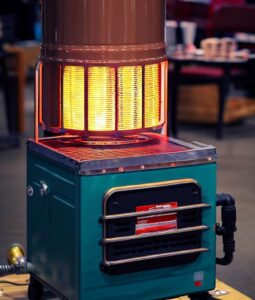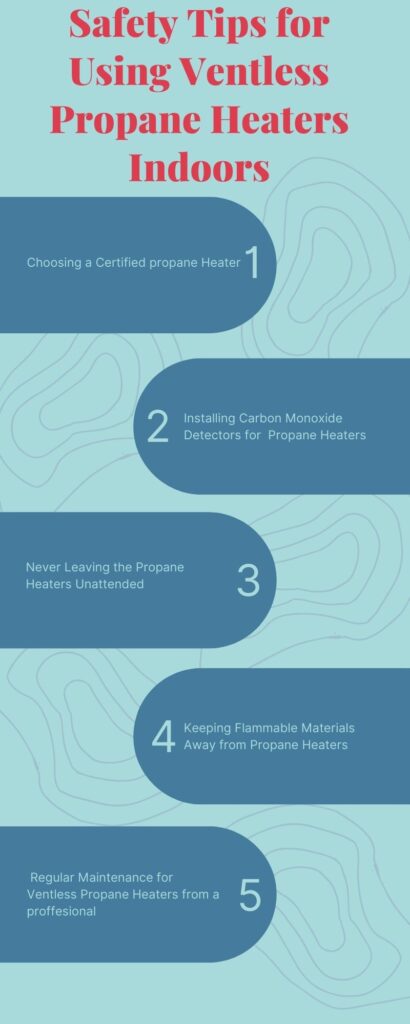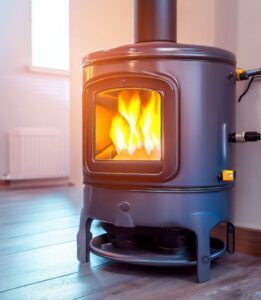Table of Contents
Introduction
As winter approaches, you may be considering a ventless propane heater to keep your indoor spaces warm. However, it’s not uncommon to worry about their safety indoors – yes, these heaters are efficient and cost-effective but they can also pose risks like carbon monoxide poisoning if not properly maintained.
This article provides a comprehensive guide on how to safely use ventless propane heaters indoors; minimizing risks while maximizing comfort. Ready to learn more? Let’s dive in!

Key Takeaways
- Ventless propane heaters pose risks of carbon monoxide poisoning when used indoors, making proper ventilation and room size considerations crucial for safety.
- Regular maintenance is important to prevent malfunctions that could lead to dangerous situations with indoor propane heaters.
- Safety tips for using ventless propane heaters indoors include choosing a certified heater, installing carbon monoxide detectors, never leaving the heater unattended, and keeping flammable materials away.
- Alternative heating options such as direct vent propane heaters or electric space heaters can provide safer alternatives for indoor heating needs.
Understanding the Safety of Ventless Propane Heaters Indoors
Ventless propane heaters used indoors pose risks of carbon monoxide poisoning, making proper ventilation and room size considerations crucial for safety. Regular maintenance is also important to prevent malfunctions that could lead to dangerous situations.
Risks of Carbon Monoxide Poisoning from Ventless Propane Heaters
Ventless propane heaters, despite their convenience and efficiency, carry the risk of emitting carbon monoxide (CO) – a perilous gas that is odorless and colorless. As part of the byproduct from burning fuel in an oxygen-starved environment, CO poisoning becomes a serious safety concern for indoor usage of these appliances.
Unlike natural air components, inhaling this particular gas starves your body tissues and organs – especially the brain and heart – off much-needed oxygen which can lead to sudden illness or even death.
The lack of vents on these heaters means there’s no outlet for harmful gases like CO to escape outside, with potential accumulation posing significant health risks over time. Exposure symptoms may include headaches, dizziness, weakness, upset stomachs or feeling confused and disoriented – but it could also be fatally silent with no noticeable signs at all.
Henceforth , proper maintenance becomes critical in ensuring your heater isn’t imperiling you to lethal levels of carbon monoxide exposure.
Proper Ventilation and Room Size Considerations
Proper ventilation and considering the size of the room are essential factors to ensure the safe use of ventless propane heaters indoors. Here’s what you need to know:
- Adequate ventilation is crucial when using ventless propane heaters. Make sure there is a constant flow of fresh air into the room where the heater is being used. This can be achieved by opening windows or using exhaust fans to circulate air.
- The size of the room plays a significant role in determining the appropriate propane heater to use. It’s important to choose a heater that is suitable for the square footage of the room. Using a heater that is too small for the space may not provide enough heat, while using one that is too large could lead to excessive heat buildup and potential safety hazards.
- Be mindful of any obstructions or barriers in the room that may impede proper airflow around the heater. Keep furniture, drapes, and other objects at a safe distance from the heater to prevent fire hazards.
- Regularly monitor carbon monoxide levels in your home with a certified carbon monoxide detector. If levels become elevated, it is crucial to ventilate the area immediately and seek professional assistance.
- Remember, never attempt to modify or tamper with your ventless propane heater as it can compromise its safety features.
Importance of Regular Maintenance for Ventless Propane Heaters
Regular maintenance is crucial when it comes to indoor propane heaters. Ensuring that your heater is in good working condition can help prevent potential safety hazards and keep your home safe.
One important aspect of maintenance is checking for any signs of wear and tear, such as loose connections or damaged valves. It’s also important to clean the heater regularly to remove any dust or debris that could potentially ignite.
Another vital part of regular maintenance is getting your propane heater inspected by a professional on a yearly basis. This inspection helps identify any potential issues that may not be visible to the naked eye, ensuring that your heater continues to function safely and efficiently.
Additionally, make sure you follow the manufacturer’s recommendations for maintenance tasks like changing filters or replacing worn-out parts.
Safety Tips for Using Ventless Propane Heaters Indoors
When using ventless propane heaters indoors, it’s important to follow these safety tips to ensure the well-being of yourself and your household.

Choosing a Certified propane Heater
It is crucial to choose a certified heater when considering the safety of using ventless propane heaters indoors. Certified heaters have undergone rigorous testing and meet strict safety standards, giving you peace of mind while heating your space.
Look for certifications such as UL or CSA, which indicate that the heater has been independently tested for quality and safety. By choosing a certified heater, you can ensure that it has proper shut-off mechanisms and built-in safety features to protect against potential hazards.
Make sure to check for these certifications before purchasing an indoor propane heater to prioritize safety in your home.
Installing Carbon Monoxide Detectors for Propane Heaters
To ensure the safety of using ventless propane heaters indoors, it is crucial to install carbon monoxide detectors. Carbon monoxide (CO) is an odorless and colorless gas that can be released by propane heaters, and prolonged exposure to high levels of CO can be life-threatening. Here are some key points about installing carbon monoxide detectors:
- Place the detector strategically: Install a carbon monoxide detector on every level of your home and near sleeping areas. This ensures that you will be alerted promptly if there are dangerous levels of CO present.
- Follow manufacturer’s instructions: Read the instructions provided with the CO detector carefully before installation. Each brand may have specific guidelines for optimal placement and maintenance.
- Test the detector regularly: To ensure proper functioning, test your carbon monoxide detectors at least once a month by pressing the test button. This helps verify that they are working correctly and able to detect any potential leaks immediately.
- Replace batteries as needed: Carbon monoxide detectors typically operate on batteries, so it is essential to replace them as recommended by the manufacturer or when they start running low. A malfunctioning detector due to dead batteries can put you at risk.
- Consider interconnected detectors: If possible, invest in interconnected carbon monoxide detectors so that when one alarm is triggered, all alarms in your home will sound simultaneously. This provides an extra layer of safety by alerting everyone in the house immediately.
- Choose certified detectors: Ensure that the carbon monoxide detectors you purchase are certified by recognized testing laboratories like Underwriters Laboratories (UL). These certifications indicate that the product has been tested for safety standards and reliability.
Never Leaving the Propane Heaters Unattended
It is crucial to never leave your indoor propane heater unattended. This simple precaution can help prevent potential accidents and ensure the safety of your home. Even though ventless propane heaters are designed with safety features, such as automatic shut-off mechanisms, it is always best practice to keep an eye on them at all times when they are in use.
Accidents can happen quickly, and being present allows you to react immediately if any issues arise. By staying vigilant and not leaving the heater unattended, you can enjoy the warmth provided by your indoor propane heater while minimizing any potential risks or dangers.
Keeping Flammable Materials Away from Propane Heaters
One crucial safety precaution when using ventless propane heaters indoors is to keep flammable materials away from the heater. This includes items such as curtains, furniture, clothing, and papers.
These materials can easily catch fire if they come into contact with a hot surface or an open flame. To minimize the risk of accidents, it is essential to maintain a safe distance between the heater and any potential combustible objects.
By doing so, you can greatly reduce the chances of a fire starting and ensure a safer environment for everyone in your home.
Alternative Heating Options for Indoor Use
There are several alternative heating options that can be used indoors, including direct vent propane heaters, electric space heaters, and radiant floor heating.
Direct Vent Propane Heaters
Direct vent propane heaters are a popular alternative to ventless models because they offer added safety features. These heaters are designed with a sealed combustion system that draws in air from outside for the burning process and then vents any exhaust gases back outdoors.
This means that the heater is not using indoor air for combustion like ventless models, eliminating the risk of carbon monoxide poisoning. Direct vent propane heaters also come equipped with oxygen depletion sensors (ODS) which automatically shut off the heater if oxygen levels in the room become too low.

In terms of efficiency, direct vent propane heaters are highly effective at providing heat while minimizing heat loss. They can be easily installed in various areas of your home and operate quietly without producing excessive noise or drafts.
Electric Space Heaters
Many people turn to electric space heaters as a safe alternative for indoor heating. These heaters are powered by electricity, which means they do not produce any carbon monoxide or other harmful gases.
Electric space heaters are generally considered safer than ventless propane heaters because they do not require combustion and do not emit any fumes or flames. They are also easy to use, portable, and come in various sizes and styles to suit different needs.
However, it is important to remember that electric space heaters can still pose fire hazards if used improperly. Always follow the manufacturer’s instructions, keep flammable materials away from the heater, and never leave it unattended while in use.
Radiant Floor Heating
Radiant floor heating is another alternative option for indoor heating. This type of heating system uses hot water pipes or electrical cables installed beneath the flooring to provide warmth throughout the room.
Unlike ventless propane heaters, radiant floor heating does not produce any fumes or gases that could potentially be harmful to your health. It also eliminates the need for bulky space heaters, giving you more freedom with your interior design.
Radiant floor heating offers several benefits, including evenly distributed heat and improved energy efficiency. With this system, heat rises from the floor and warms up everything in its path, creating a cozy and comfortable environment.
Additionally, radiant floor heating can help reduce energy consumption as it operates at lower temperatures compared to traditional forced-air systems.
Although radiant floor heating may require professional installation and can be more expensive upfront compared to other options, it provides long-term cost savings by reducing energy bills over time.
It is worth considering if you want a safe and efficient way to heat your home without relying on ventless propane heaters.
FAQs
1. Are ventless propane heaters safe to use indoors?
Ventless propane heaters are designed and certified for indoor use, but it is important to follow safety guidelines and ensure proper ventilation in the area where they are being used.
2. What are the potential risks of using a ventless propane heater indoors?
The primary risk associated with using a ventless propane heater indoors is the release of carbon monoxide (CO) gas. Without proper ventilation, CO can build up to dangerous levels, leading to symptoms such as headaches, dizziness, nausea, and even death.
3. How can I ensure the safe operation of a ventless propane heater indoors?
To safely operate a ventless propane heater indoors, it is essential to have adequate fresh air circulation in the room or space where the heater is being used. This can be achieved by opening windows or doors periodically or installing additional vents for proper air exchange.
4. What precautions should I take when using a ventless propane heater indoors?
Some precautions to take when using a ventless propane heater indoors include ensuring that the unit is properly installed according to manufacturer instructions, keeping flammable materials away from the heater, never leaving it unattended while in operation, and installing carbon monoxide detectors nearby for early warning detection of any potential leaks.
Conclusion
In conclusion, ventless propane heaters can be safely used indoors as long as proper precautions and safety measures are followed. It is essential to choose certified heaters designed for indoor use, install carbon monoxide detectors, ensure adequate ventilation, and never leave the heater unattended.
Alternatively, considering other heating options like direct vent propane heaters or electric space heaters can also provide safe alternatives for indoor heating needs. Prioritizing safety and following these guidelines will help ensure a warm and secure environment during the colder months.
References :
Are Propane Heaters Safe for Indoors?
How to Safely Use Ventless Gas Heaters
The Truth About Vent Free Gas Heaters
